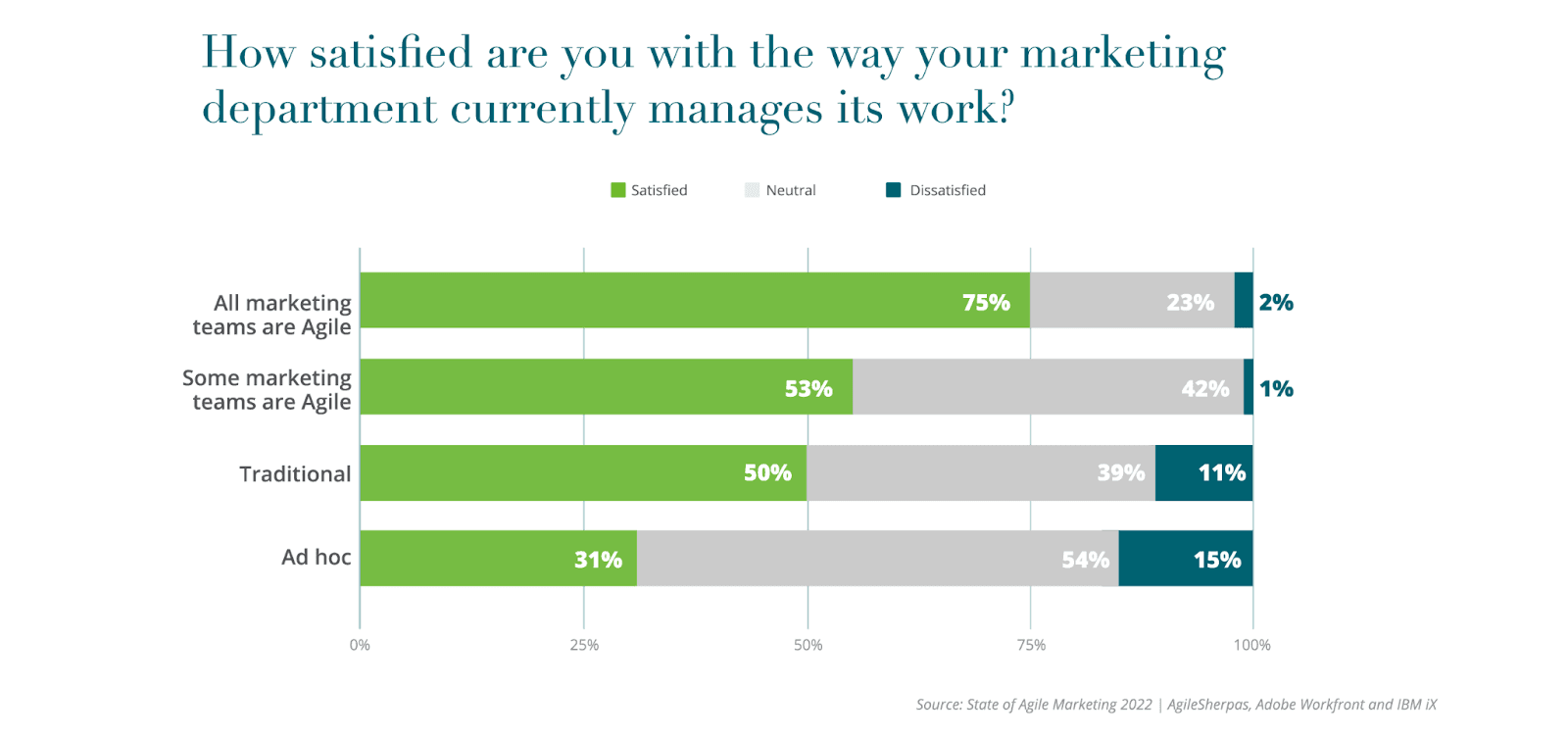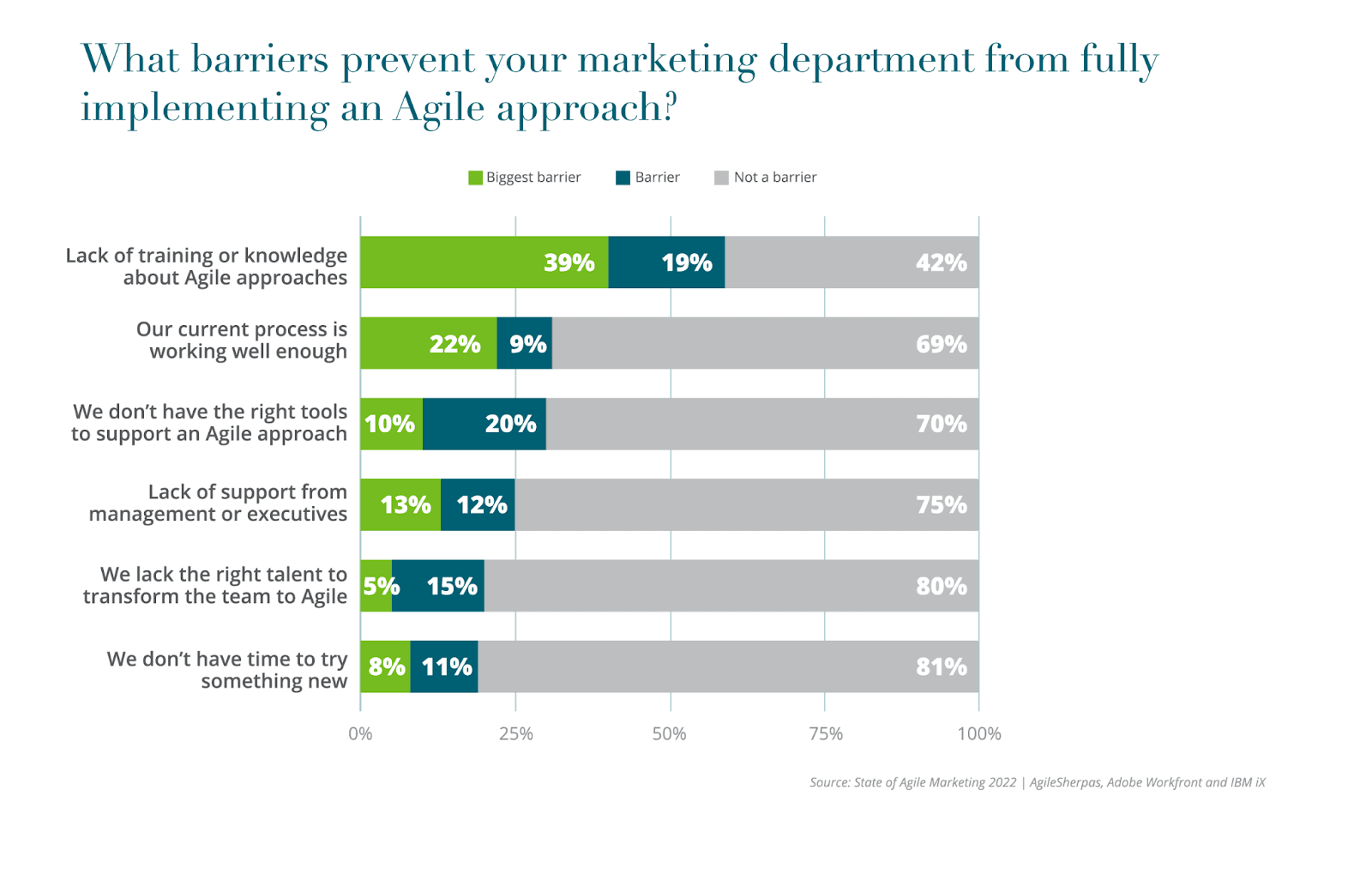Marketing is a dynamic business area that constantly needs to keep up with rapid shifts and continuously evolving customer needs. To do that, many marketing professionals are leaning into Agile ways of working to govern their internal processes.
If you’re a marketer going down this path, you’re likely not the first. Going Agile is a journey that results in accumulating invaluable data about culture, process, and ourselves as contributors.
In this piece, marketers share the progress they’re experiencing in their transformations, the benefits and challenges they’re experiencing using Agile, and insights into the future of marketing agility through data points from the most recent 5th Edition of the State of Agile Marketing Report.
Let’s dive into a pool of fresh data provided by over 500 marketers!
Agile Marketing Confirms Its Best-in-Class Status
Agile is becoming a preferred way to manage projects and execute campaigns. The findings reveal that 43% of the marketers surveyed use some form of Agile in their work, relying on daily standups, backlogs, sprints, Kanban boards, etc.
48% of the remaining respondents say they’ll be starting their transformation journey within the next six months, with another 43% saying it’ll happen within the year. In other words, most marketers are either using Agile or planning to start using it in 2022.

The data shows that fully Agile teams enjoy higher levels of satisfaction with the way their work is managed compared to those who use a traditional or ad hoc approach to marketing. An overwhelming 75% of Agile marketers claim they are satisfied with how they currently manage their work.

New data points also tell the story of how Agile found its way into marketing organizations in the first place. 31% of respondents share that they experimented with a few Agile projects before broadly incorporating the methodology. This data supports the popularity of Agile and that it is the best and safest option to introduce agility into the organization.
28% of respondents say that someone who already used Agile in a different company before joining their own sponsored the transformation. 20% revealed that an executive mandated agility across the organization. Lastly, 15% share that Agile originated in a different department such as product development and cross-pollinated with marketing.
There’s no secret formula to a successful introduction to Agile. No matter how Agile arrives at your organization, it’s how you apply it after the fact that matters most.
New Challenges Unlocked
As Agile adoption grows more rapidly, we continue to notice more and more patterns in the barriers people are encountering in their use of its frameworks.
Year after year, the data supports the conclusion that Agile education is a make-it-or-break-it factor for any transformation. 58% of marketers list a lack of training and knowledge about Agile approaches as their most significant barrier to successfully implementing Agile.

Among the other barriers to a successful Agile transformation are lack of proper tools, no support from executives, and the absence of a strong need for a drastic change.
In terms of sustaining agility in the long run, 42% of the respondents share that their biggest challenge has been people reverting to old non-Agile approaches, managing unplanned work, proper estimation of team capacity and velocity, and a lack of perspective for the future.
Yet, we know that marketers aren’t making the best use of the tools they know to be to their advantage when adopting Agile. The most valuable tactic picked by 80% of the survey respondents is implementing an Agile management tool. Unfortunately, only 49% of them are actually using one.
There are various challenges on the path to successful Agile transformation, but there are also resources for dealing with each. You can explore many Agile marketing podcasts and webinars, books, case studies, and certifications to overcome your biggest barriers and reach the summit of agility.
Reaping the Benefits of Agility
With hard work and dedication, sooner or later, visible results arrive. Indeed, 63% of marketers who began using Agile found they could better manage changing priorities and improve visibility into project status. They even noticed an increase in team morale and productivity.

Agile marketing teams can better manage distributed teams, prioritize work more effectively, focus on quality and align with business objectives.
They are satisfied with how their organization manages projects, which, in turn, makes them confident that they can handle fast-paced work and push back on unplanned work.
The benefits and value are compelling key drivers that inspire organizations to go Agile progressively. However, you can’t expect a long-lasting change if you require teams to change how they work without introducing core Agile values and principles and training to support the new mindset.
Agile Practices and Frameworks Marketers Love
Each year, when the new report is published, we confirm something we know to be true. A one-size-fits-all approach to Agile does not work for marketers. With unique needs, it’s no wonder they tend to tailor and customize, preferring to develop hybrid frameworks instead of learning Scrum by the book.
Specific frameworks can be too limiting; instead of bringing value, they take it away. The great thing about hybrid approaches is that you can mix and match elements of the frameworks and practices that best suit your needs.
61% of the surveyed marketers share that hybrid or Scrumban is the framework their department follows most closely.
We have noticed a shift in numbers for several Agile marketing practices relative to last year, including more Scrum-centric practices like sprint planning. Probably, this decline indicates the wider variety of hybrid frameworks in use. Another possibility is that teams are practicing just-in-time planning instead of two-week sprint planning.
Overall, the use of sprint planning declined by 20% this year. We assume this is another indication that fewer and fewer marketers are employing sprints and are instead gravitating toward a more continuous flow, Kanban-style hybrid.
We also see a 14% decline in the use of physical kanban boards year over year, which makes sense as hybrid and distributed work is becoming a permanent part of marketing.
In terms of Agile practices, the top three aren’t a surprise to anyone. 50% of survey respondents share that they have daily standup meetings, followed by 41% who do retrospectives, and 38% who use Sprint or iteration planning.
From Marketing to Organizational Agility
As part of our 5th State of Agile Marketing Report, we were interested in exploring the relationship between marketing agility and holistic business agility. So, we asked survey respondents about Agile outside of marketing and spotted an emerging trend.
The Agile marketing approach to effectively tackling work is enticing other departments to try it. Agile is growing and spreading to adjacent functions of the organization, such as sales, finance, and HR. The percentage of sales teams using Agile has nearly doubled in a year, climbing from 18% to 33%, followed by product management, finance, and HR.
This is great news for Agile marketers as 74% believe it would be easier to work with other departments if they followed an Agile methodology. It seems the time has come for agility to scale across the organization.
Year after year, the number of people using Agile, especially in sales, finance, and HR, has jumped significantly. Wider business agility transformations will be able to unlock the full potential Agile can bring to the organization at large. The future of Agile awaits, and it’s more exciting than ever!

